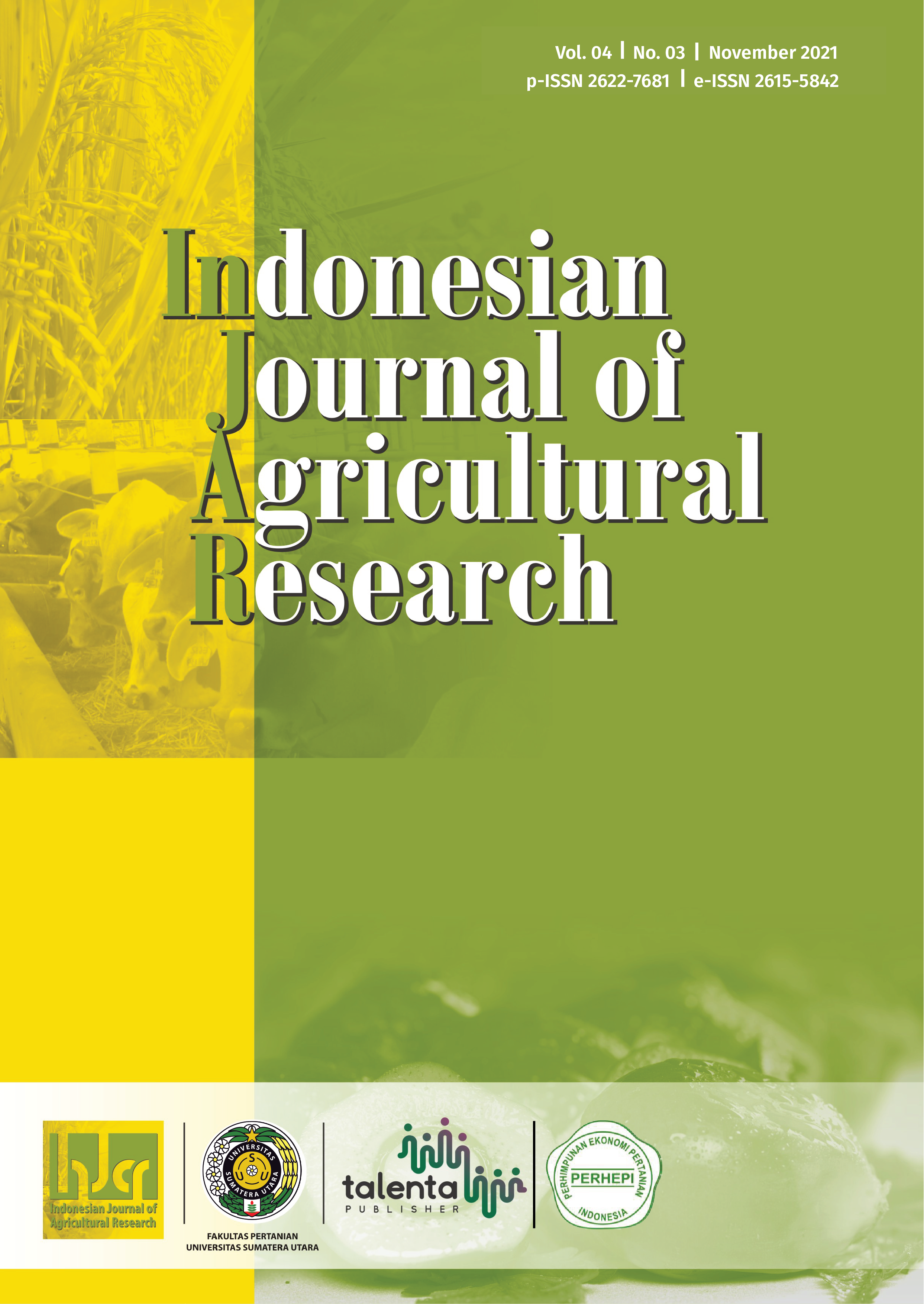Analysis of Garlic Import Demand Trend in Indonesia
DOI:
https://doi.org/10.32734/injar.v4i3.6306Keywords:
garlic, import, trend demandAbstract
This research aims to find out the development patterns and trends in import demand for garlic in Indonesia. Observing the pattern and trend of garlic imports will provide invaluable information for program planning, program evaluation, and policy development activities for domestic garlic development in the future. The data used in this study is the annual demand for garlic imports in Indonesia from 1995-2019. Three trend methods are applied including linear, quadratic, and exponential methods. The best trend was determined by examining the MAD, MES, ME, and MAPE values. The best trend model for garlic import demand in Indonesia, according to this study, is an ascending exponential trend. The trend of garlic import demands in Indonesia increases along with the increase of garlic consumption and domestic garlic production in Indonesia.
Downloads
References
A. W et al., Profil Komoditas Bawang Putih (Bagian Proyek Pengkajian Teknologi Pertanian Partisipatif). Jakarta: Banglibangtan Kementerian Pertanian, 2004.
Kementerian Pertanian, Outlook Bawang Putih Komoditas Pertanian Subsektor Holtikultura. Pusat Data dan Sistem Informasi Pertanian, 2019.
UN Comtrade, 2020. [Online]. Available: https://comtrade.un.org/data/
Tabolid Sinartani “Membangkitkan kembali kejayaan white diamond,†2016. [Online]. Available: https://tabloidsinartani.com/detail/indeks/hortiku
Alinea, “Indonesia ekspor bawang putih setelah 25 tahun impor,†2020. [Online]. Available: https://www.alinea.id/bisnis/indonesia-ekspor-bawang-putih-setelah-25-tahun-impor-b1ZRR9wwx .
F. Marisa, “Analisis faktor-faktor yang mempengaruhi impor bawang putih di indonesia tahun 1980-2012,†Economics Development Analysis Journal, vol. 3, no. 2, pp. 235–242, 2014, doi: 10.15294/edaj.v3i2.3820.
I. Shofiyah and T. Sugiarti, “Tren dan faktor-faktor yang mempengaruhi volume impor bawang putih di Indonesia,†Agriscience, vol. 1, no. 1, pp. 151–165, 2020.
Meleriansyah, S. Iskandar, and R. Kurniawan, “Analisis faktor yang mempengaruhi volume impor dan produksi bawang putih di Indonesia,†Societa, vol. 3, no. 2, pp. 95–102, 2014.
G. S. Permadi, “Analisis permintaan impor kedelai indonesia,†Eko-Regional, vol. 10, no. 1, 2015.
R. I. Hairani, J. M. M. Aji, and J. Januar, “Analisis Trend produksi dan impor gula serta faktor-faktor yang mempengaruhi impor gula Indonesia,†Berk. Ilm. Pertan., vol. 1, no. 4, pp. 77–85, 2014.
Astia, “Peramalan volume ekspor kelapa sawit Indonesia,†J. Agribisnis Unisi, vol. 8, no. 1, pp. 36–47, 2019.
A. Sayidah, S. Iskandar, and H. Iswarini, “Analisis faktor-faktor yang mempengaruhi ekspor biji pala Indonesia,†Societa, vol. 3, no. 2, pp. 103–107, 2014.
N. Bachri, Statistika Dasar Untuk Bisnis Teori, Pendekatan dan Contoh-contohnya. Jawa Barat: CV Jejak, 2019.
A. B. Santoso and N. Nurfaizin, “Proyeksi daya dukung pakan dan populasi sapi di Provinsi Maluku,†Agriekonomika, vol. 6, no. 1, pp. 1–11, 2017, doi: 10.21107/agriekonomika.v6i1.1001.
H. Tanaddy and F. Andrew, “Analisis perbandingan metode regresi linier dan exponential smoothing dalam parameter tingkat error,†J. Tek. dan Ilmu Komput., vol. 7, no. 2, pp. 242–250, 2013.
Wahyudi and S. Tri, Statistika Ekonomi Konsep, Teori dan Penerapan. Malang: UB Press, 2017.
K. Sukiyono and R. Rosdiana, “Pendugaan model peramalan harga beras pada tingkat grosir,†J. AGRISEP, vol. 17, no. 1, pp. 23–30, 2018, doi: 10.31186/jagrisep.17.1.23-30.
R. Karim, A. Awala, and M. Akher, “Forecasting of wheat production in Bangladesh,†Bangladesh J. Agric. Res, vol. 35, no. March, pp. 17–28, 2010.
D. Pangestika, Samanhudi, and E. Triharyanto, “Kajian pemberian IAA dan paclobutrazol terhadap pertumbuhan eksplan bawang putih,†J. Kewirausahaan dan Bisnis, vol. 16, no. 09, 2015, doi: https://doi.org/10.20961/jkb.v17i9.5082.
Prastuti, T. Samijan, and J. Pramono, Intensifikasi Budidaya Bawang Putih. Jawa Tengah: Balai Pengkajian Teknologi Pertanian, 2011.
FAOSTAT, 2020. [Online]. Available: http://www.fao.org/faostat/en/#data/TP
A. H. Putra, A. Ratya, and S. Suhartini, “The evaluation of Indonesia import policies of garlic,†Greener J. Bus. Manag. Stud., vol. 5, no. 1, pp. 016–030, 2015, doi: 10.15580/gjbms.2015.1.081414329.
Liputan. 6, “Kementan: Impor bawang putih dibuka bebas sejak 1998,†2017. [Online]. Available: https://www.liputan6.com/bisnis/read/2957494/kemen
R. Mudassir, “Apa sih penyebab impor RI membengkak pada April 2018?,†Bisnis.Com, 2018.
Downloads
Published
How to Cite
Issue
Section
License
Copyright (c) 2022 Indonesian Journal of Agricultural Research

This work is licensed under a Creative Commons Attribution-ShareAlike 4.0 International License.



















